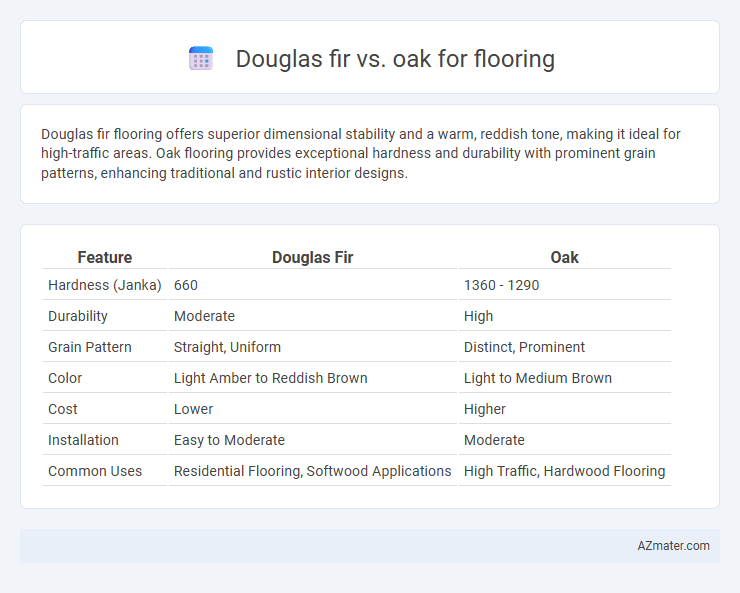Douglas fir flooring offers superior dimensional stability and a warm, reddish tone, making it ideal for high-traffic areas. Oak flooring provides exceptional hardness and durability with prominent grain patterns, enhancing traditional and rustic interior designs.
Table of Comparison
| Feature | Douglas Fir | Oak |
|---|---|---|
| Hardness (Janka) | 660 | 1360 - 1290 |
| Durability | Moderate | High |
| Grain Pattern | Straight, Uniform | Distinct, Prominent |
| Color | Light Amber to Reddish Brown | Light to Medium Brown |
| Cost | Lower | Higher |
| Installation | Easy to Moderate | Moderate |
| Common Uses | Residential Flooring, Softwood Applications | High Traffic, Hardwood Flooring |
Introduction: Douglas Fir vs Oak Flooring
Douglas fir flooring offers a warm, reddish-brown hue with a straight grain and softer texture, making it easier to install and more cost-effective than oak. Oak flooring, known for its durability and distinctive grain patterns, provides superior hardness and resistance to wear, ideal for high-traffic areas. Both wood types vary in color, hardness, and maintenance, influencing long-term performance and aesthetic preferences in flooring choices.
Wood Characteristics and Appearance
Douglas fir flooring features a warm, reddish-brown hue with distinctive knots and straight grain patterns, offering a rustic and natural look. Oak flooring is prized for its durability and prominent grain, showcasing classic patterns in light to medium brown shades with occasional reddish undertones. Both woods provide excellent hardness, but oak tends to be more resistant to dents and wear due to its higher Janka hardness rating.
Hardness and Durability Comparison
Douglas fir flooring offers a Janka hardness rating around 660, making it relatively softer and more prone to dents and scratches compared to oak. Oak, both red and white varieties, boasts higher hardness ratings ranging from 1,290 to 1,360 on the Janka scale, providing superior durability and resistance to wear. For high-traffic areas demanding long-lasting flooring, oak is generally a preferable choice due to its robust hardness and enhanced durability characteristics.
Color Variations and Grain Patterns
Douglas fir flooring offers warm reddish-brown hues with distinct knots and straight, pronounced grain patterns, emphasizing a rustic and natural aesthetic. Oak flooring showcases a broader color range from light beige to deep brown with prominent, swirling grain patterns that create a classic and elegant look. Both woods provide unique visual textures, with Douglas fir highlighting uniformity and Oak offering more dramatic variations in color and grain.
Installation Methods and Ease
Douglas fir flooring offers easier installation methods due to its softer texture and flexibility, making it more forgiving during nailing or clicking processes compared to oak. Oak flooring, being a harder and denser hardwood, often requires more precise tools and techniques, including pre-drilling and acclimation to prevent warping or splitting. Both options can be installed via nail-down, glue-down, or floating methods, but Douglas fir's adaptability often results in faster installation and fewer complications.
Maintenance and Longevity
Douglas fir flooring offers moderate durability with a Janka hardness rating of 660, requiring regular maintenance such as sweeping and occasional refinishing to prevent dents and scratches over time. Oak, with a higher Janka hardness of 1290 for red oak and 1360 for white oak, provides superior wear resistance and longevity, often lasting several decades with minimal upkeep beyond cleaning and periodic refinishing. Both woods benefit from protective finishes, but oak's denser grain structure makes it more resistant to moisture and wear, reducing long-term maintenance needs.
Cost Comparison: Douglas Fir vs Oak
Douglas fir flooring generally costs between $3 to $6 per square foot, making it a more budget-friendly option compared to oak, which typically ranges from $5 to $10 per square foot. Oak, especially red and white varieties, tends to be more expensive due to its hardness, durability, and popularity in high-end homes. For large-scale projects, Douglas fir offers cost savings without sacrificing appearance, while oak's higher price is often justified by its superior wear resistance and longer lifespan.
Environmental Impact and Sustainability
Douglas fir flooring offers a more sustainable choice due to its faster growth rate and higher carbon sequestration compared to oak, which matures over several decades. Oak is typically harvested from slower-growing forests, leading to a larger environmental footprint and potential deforestation concerns. Using FSC-certified Douglas fir can further reduce ecological impact by ensuring responsible forest management and biodiversity conservation.
Best Applications for Each Wood Type
Douglas fir flooring excels in residential settings with moderate foot traffic, offering warm tones and natural elasticity that resist dents and scratches, making it ideal for living rooms and bedrooms. Oak flooring is preferred for high-traffic commercial and residential areas due to its exceptional hardness, durability, and distinct grain patterns, providing long-lasting performance in kitchens, hallways, and entryways. Both woods offer versatile finishes, but Douglas fir suits rustic or coastal designs, while oak complements traditional and contemporary interiors.
Conclusion: Choosing the Right Wood for Your Floor
Douglas fir offers a warm, reddish hue with excellent softness that makes it easier to install and comfortable underfoot, ideal for areas with moderate foot traffic. Oak, known for its remarkable hardness and durability, withstands heavy wear and is more resistant to dents, making it a superior choice for high-traffic spaces. Selecting between Douglas fir and oak depends on balancing desired aesthetics, durability requirements, and the specific environment of the flooring area.

Infographic: Douglas fir vs Oak for Flooring
 azmater.com
azmater.com